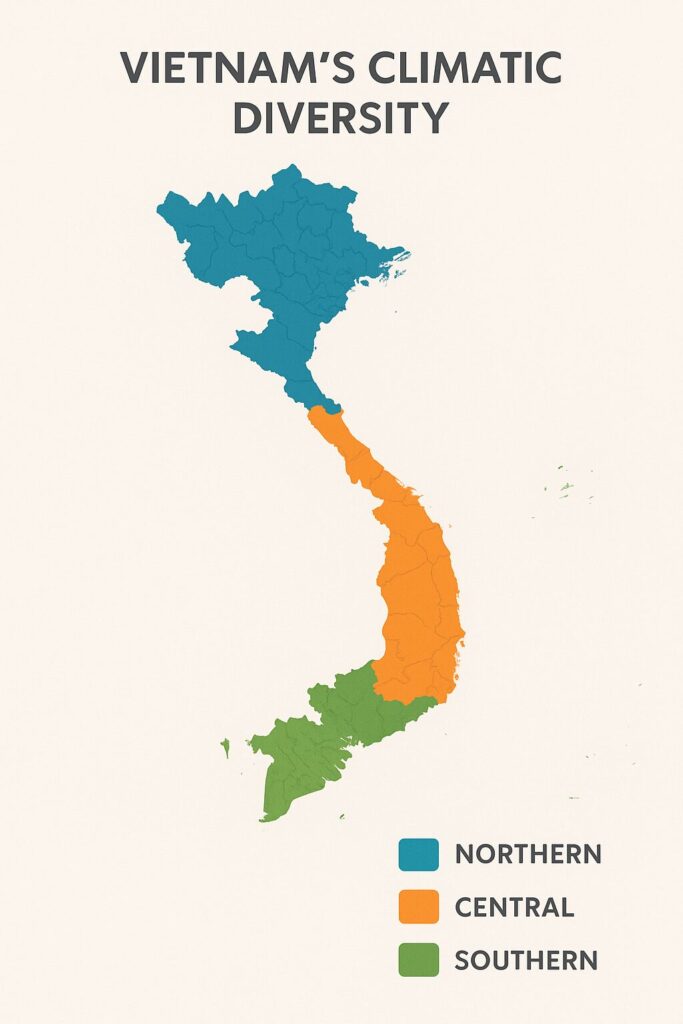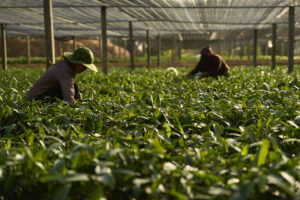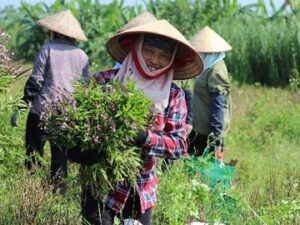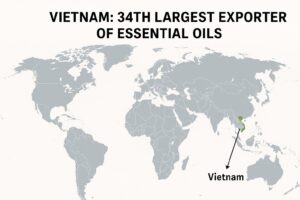According to oec.world, Vietnam’s essential oil industry has emerged as a significant contributor to the global market, leveraging the country’s unique climatic conditions and rich biodiversity. In 2023, Vietnam exported approximately $18.4 million worth of essential oils, positioning itself as the 34th largest exporter globally. This growth reflects not only the country’s natural endowments but also its commitment to sustainable practices and rigorous quality assurance.
1. Vietnam’s Climatic Diversity: A Natural Advantage
Vietnam’s geography spans over 15 degrees of latitude, resulting in a range of climatic zones that are uniquely suited to the cultivation of various aromatic plants.
1.1 Northern Vietnam
Characterized by a humid subtropical climate with four distinct seasons, the north experiences cold, dry winters and hot, wet summers. This is ideal for growing temperate plants such as peppermint and basil, which thrive in cooler temperatures and define seasonal changes.

1.2 Central Vietnam
This region features a tropical monsoon climate, with distinct dry and rainy seasons. The high altitudes of areas like the Central Highlands provide optimal growing conditions for cinnamon and clove. The diversity in terrain supports multiple growing cycles and plant species.
1.3 Southern Vietnam
Boasting a consistent tropical climate, the south supports year-round cultivation of lemongrass, citronella, and other warm-weather crops. Steady rainfall and sunlight make this region especially favorable for high-yield essential oil farming.
These microclimates contribute to Vietnam’s rich essential oil portfolio, making it a valuable player in the global industry.
2. Climate’s Impact on Essential Oil Quality
The quality of essential oils is closely linked to the environmental conditions in which the source plants are grown. Each climatic factor contributes uniquely to the plant’s biochemical composition.
2.1 Temperature
Optimal temperature ranges enhance essential oil biosynthesis. Warmer climates like those in southern Vietnam help maximize the yield and intensity of oils such as citronella, which depend on prolonged sunlight and warmth for peak compound formation.
2.2 Humidity and Rainfall
Humidity supports plant hydration and growth, while balanced rainfall prevents stress or disease. Overly wet conditions, however, can encourage fungal growth and reduce oil quality, necessitating precise management.
2.3 Sunlight
Photosynthesis, driven by sunlight, is essential for plant health and essential oil production. Regions with high solar exposure, such as the Central Highlands, are ideal for cultivating high-oil-content crops like basil and cinnamon.
By strategically aligning crop selection with climate profiles, Vietnamese producers ensure both volume and quality in their oil output.
3. Regional Highlights in Essential Oil Production
Each region of Vietnam offers specific advantages due to its unique environmental and socio-economic attributes.

3.1 Central Highlands
According to FNCEXPORT, regions like Lâm Đồng and Đắk Lắk benefit from fertile volcanic soils and high elevation. These provinces are leaders in cultivating cinnamon and basil. Local government programs support sustainable farming practices and product diversification (source: FNCEXPORT).
3.2 Northern Vietnam
With cooler climates, provinces such as Lào Cai and Hà Giang specialize in peppermint and temperate herbs. Clearly defined seasonal cycles allow for careful planning of harvests to preserve oil quality and potency.
3.3 Southern Vietnam
The Mekong Delta and nearby lowland regions are ideal for cultivating lemongrass and citronella, thanks to tropical humidity and consistent temperatures. These crops thrive in such environments and are key exports for Vietnam.
Each region contributes distinct aromatic qualities, enriching the variety of essential oils available for global distribution.
4. Sustainable Practices and Quality Assurance
Vietnam has prioritized sustainability and quality control to ensure its essential oils meet international standards and consumer expectations.
4.1 Sustainable Farming
Efforts in the Central Highlands aim to reduce poverty through essential oil cultivation. Farmers receive training in species selection, organic farming, and eco-friendly processing methods. These projects also promote gender equality and community involvement.

4.2 Quality Control
Producers use techniques such as Gas Chromatography-Mass Spectrometry (GC-MS) to test for chemical composition and purity. These standards help maintain Vietnam’s competitive edge in international markets.
4.3 Community Engagement
Ethnic minorities and women often play a central role in essential oil production. Their involvement ensures that traditional agricultural knowledge is preserved and integrated into modern farming methods.
Sustainable production safeguards the environment while also improving economic resilience among rural communities.
5. Market Trends and Opportunities
Vietnam is gaining momentum in the essential oil market due to growing demand for natural and sustainable products worldwide.
5.1 Export Growth
In 2023, Vietnam’s essential oil exports reached $18.4 million. This steady growth positions the country as a trusted supplier of high-quality, natural essential oils (source: OEC).
5.2 Market Expansion
Global demand for essential oils is projected to grow at a CAGR of 9.1% through 2030, reaching over $26 billion. Vietnam’s diverse oil offerings and scalable production make it a strong contender in this expanding market (source: OpenPR).
Based on OEC and OpenPR sources, Vietnam’s essential oil industry shows robust potential for international growth. OEC trade data highlights the country’s steady upward trajectory in global exports, emphasizing Vietnam’s growing reputation as a reliable supplier. Meanwhile, OpenPR’s market analysis forecasts a strong surge in worldwide demand, projecting a market value of over $26 billion by 2030. This positions Vietnam favorably, not just because of its production capabilities, but also due to its strategic alignment with global trends emphasizing natural, sustainable, and diverse product offerings.
5.3 Government Support
Policy initiatives promoting organic agriculture and sustainable development further bolster the industry’s prospects. These policies enhance Vietnam’s visibility and trustworthiness on the global stage.
The confluence of favorable climate, policy support, and global trends paints a promising picture for Vietnam’s essential oil industry.
6. Challenges and Future Outlook
While the outlook is positive, the industry must navigate certain risks and barriers to maintain growth.

6.1 Climate Change
Vietnam is highly vulnerable to climate change impacts such as rising sea levels, unpredictable rainfall, and temperature extremes. These factors can disrupt crop cycles and reduce yields.
6.2 Land Use Pressure
Urbanization and industrial expansion limit arable land, threatening essential oil farming areas. This may lead to increased competition and potential degradation of farming zones.
6.3 Global Competition
Countries like India and Brazil dominate global essential oil production. Vietnam must continue to innovate in cultivation, processing, and branding to maintain a competitive edge.
Future Outlook: Through targeted investments in technology, training, and market development, Vietnam can secure a strong position in the essential oil industry. Its unique climate, biodiversity, and commitment to sustainability form a powerful foundation for future growth.
7. Conclusion
Vietnam’s climate plays a central role in defining the character and quality of its essential oils. From the temperate highlands to the tropical lowlands, each region offers distinct advantages for cultivating a wide range of aromatic plants. When paired with sustainable practices and stringent quality controls, Vietnam’s natural endowments give it a competitive edge in the global essential oil market. As international demand for clean, natural products continues to rise, Vietnam stands poised to become a world leader in essential oil production.

